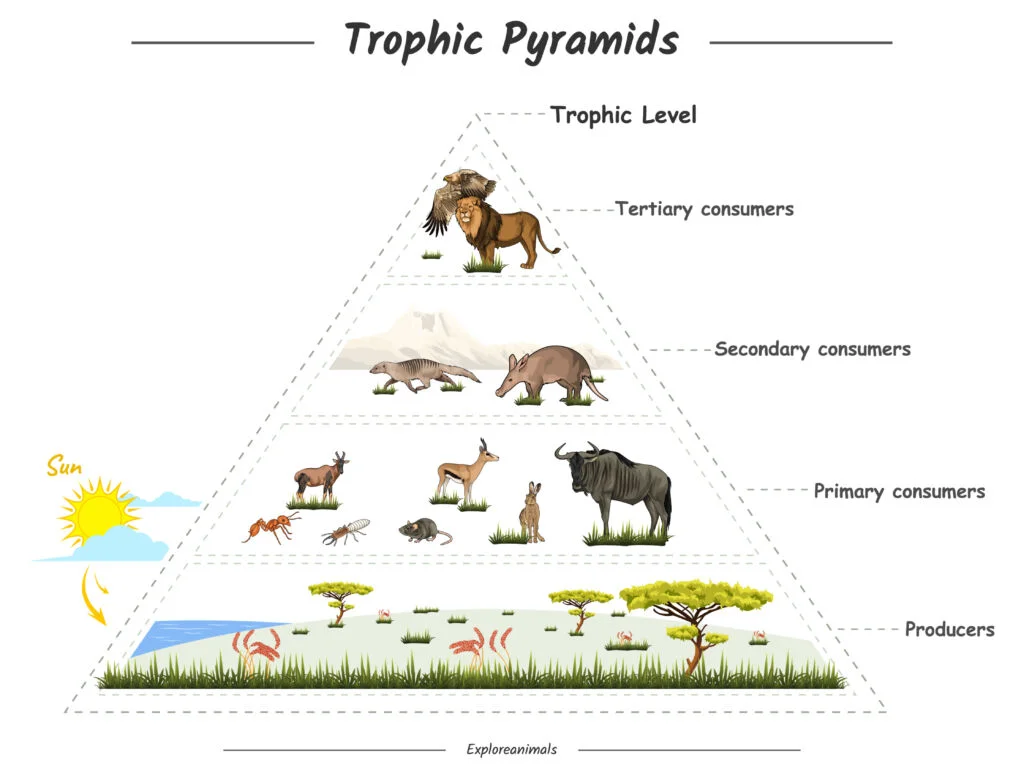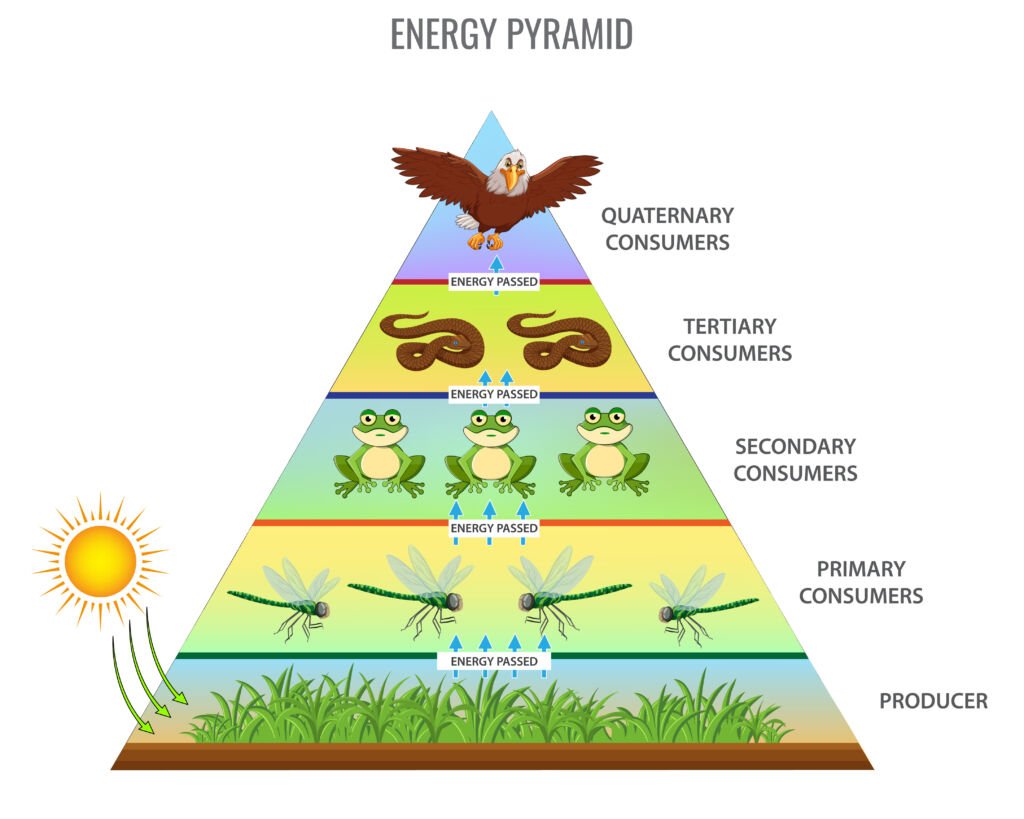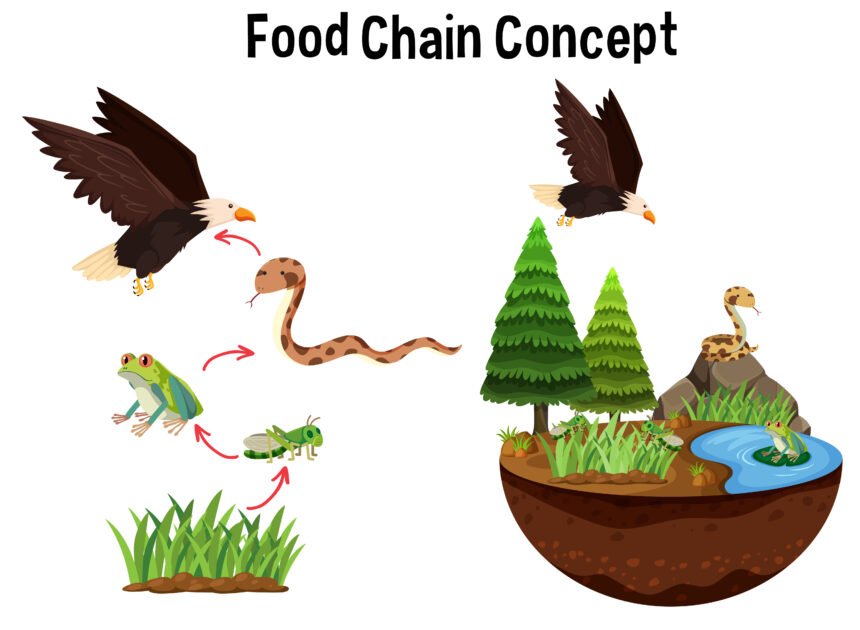●⫸ What is a Food Chain?
A food chain is a linear sequence of organisms where each living thing depends on the one below it as a food source. It shows how energy and nutrients are passed from one creature to another.
In other words, a food chain is a feeding correlation between the two organisms that comprise our ecosystem.
A food chain depicts the energy mechanisms in ecosystems. Food chains of organisms varying from producers to consumers exist in every ecosystem on the planet.

The producers are at the bottom of the food chain, while the consumers who eat those producers are referred to as primary consumers. Secondary and tertiary consumers are higher-level consumers who consume those organisms.
●⫸ What are multiple Food Chains called?
A food web is composed of all the food chains inside one ecosystem. Every living creature in an ecosystem is a part of several food chains. Each food chain represents one possible path for energy and nutrients as they move through the ecosystem. A food web is made up of all of the interrelated and overlapping food chains in an ecosystem.
⫸ Types of Food Chain
The food chain is divided into two types, which are as follows:
1. Based on the Source of Energy
The food chain is divided into two types, which are as follows:
a) Detritus Food Chain – This includes a variety of organisms and plants such as algae, bacteria, fungi, protozoa, mites, insects, and worms, among others. This begins with decomposing organic matter. The energy consumed by composers and detritivores is consumed by smaller organisms such as carnivores.
b) Grazing Food Chain – This begins with green plants and progresses through herbivores and carnivores. The lowest trophic level in this food chain obtains energy from photosynthesis.
2. Based on Habitat
- Terrestrial Food Chain: A food chain that occurs on land. Example: Grass → Rabbit → Fox
- Aquatic Food Chain: A food chain that occurs in water environments. Example: Phytoplankton → Zooplankton → Small fish → Large fish
◆ Trophic Levels of Food Chain
The food chain begins at the bottom with producer organisms and progresses in a single direction up the series. Trophic levels of the food chain are nothing but the consecutive levels of a food chain. The position of any living organism within a food chain determines its trophic level. A food chain has several trophic levels.
1) Primary Producers:
Autotrophs form the primary or base level. These are organisms that can produce their food from carbon dioxide and convert it into energy with the presence of sunlight.
These are plants and algae, respectively. They do not eat other organisms but instead draw nutrients from the soil or the water and use photosynthesis to produce their food. They are referred to as primary producers.
2) Primary Consumers:
The second trophic level is made up of heterotrophic organisms or those that feed on the very first trophic level, the autotroph (plants) biomass. Herbivores include tiny species that feed on microscopic algal cells on the surface of lakes, ponds, and oceans, as well as much larger mammalian herbivores like mice, deer, cows, and elephants.
Herbivores use the fixed energy and nutrients in one‘s food, autotrophic biomass, to power their metabolic functions and grow. Caterpillars, insects, grasshoppers, termites are examples of primary consumers.

3) Secondary Consumers:
The next level is the creatures that eat herbivores. These are known as secondary consumers. Such as a snake that eats rabbits. As a result, snakes are secondary consumers.
4) Tertiary Consumers:
Tertiary consumers are the next consumer level. Tertiary consumers, such as killer whales, are carnivores that consume other carnivores. Seals and sea lions are prey for killer whales. These are carnivorous creatures that prey on fish, squid, and octopuses.
5) Quaternary Consumers:
The quaternary consumers occupy the next level. They are usually carnivorous animals that prey on tertiary consumers. Apex predators are the ones who live at the top of a food chain and prey on no other creatures.
Quaternary consumers include lions, wolves, polar bears, humans, and hawks.
6) Decomposers:
Organisms that biodegrade dead plants and animals are known as decomposers. They also decompose other organisms’ waste. They are an important component of the food chain since they maintain a steady supply of nutrients for primary producers.
Without decomposers, plants would be unable to obtain energy and, as a result, the environment would be contaminated with dead organisms and waste.
◆Example of a simple food chain:
- Producer: Grass
- Primary Consumer: Grasshopper
- Secondary Consumer: Frog
- Tertiary Consumer: Snake
- Decomposer: Bacteria
◆ The Importance of Food Chain
- These are the biosphere’s living components. These are how energy is transferred from one level to another. Materials and nutrients are also transferred through food chains.
- It represents organisms in an ecosystem connected via the transfer of energy and nutrients, beginning with an autotrophic organism like a plant and continuing with each organism being consumed by one higher up the chain.
- It also shows how organisms are related to one another via the food they consume.
- We are all reliant on food to survive. Energy is required for the biotic world to continue growing. A food chain describes how a specific organism obtains its food.
- It is a system for identifying who eats whom in a biological community or ecosystem to obtain food.
- A food chain is a diagram depicting the transfer of energy from one organism to the next and so on. To survive, everyone requires the energy released through a food chain.
- Scientists can learn more about ecosystems and how to keep them balanced by studying food chains.
◆ Transfer Of Energy in And Between Organisms
Energy can be conveyed and transferred from one organism to another within the food chain. Plants get their energy from photosynthesis, whereas mammals get their energy from food – whether that is eating other animals or eating vegetation.
Energy flows through ecosystems within food chains. It all starts with producers, the foundation of the chain. These organisms, like plants, capture sunlight and transform it into energy. Primary consumers, often herbivores, eat the producers to get their share of the energy. Secondary consumers, carnivores or omnivores, come next, feeding on primary consumers.
Then, tertiary consumers, often apex predators, prey on the secondary consumers. In some complex food chains, you might even find quaternary consumers at the very top. Each of these steps in the chain represents a trophic level.
A food web is formed when food chains are linked together.
So, how does all of this energy enter the food web and how is it distributed?
Photosynthesis is the process by which plants obtain energy from the sun. This energy can then be passed down the food chain from one organism to the next. The producer is the organism that obtains energy from sunlight. Plants are frequently involved, but bacteria can also play a role in some cases.

- Even though producers carry energy from the sun into the food chain, consumers make up most of it. Predators, scavengers, and parasites are examples of these. Only 10% of a plant’s energy is passed on when a primary consumer eats it.
- At each trophic level, some energy is lost as heat or used for various metabolic activities. Lindeman was the first person to investigate trophic efficiencies.
- As per Lindeman’s law of 10%, the level of energy transfer through one trophic level to the other is 10%, or we can assume that only 10% of the net primary productivity of producers ends up as herbivores and so on to the next trophic level.
- As energy passes from one trophic level to the next, only about 10% continues its journey as stored energy within the consumer’s body. The rest takes different paths: it fuels the organism’s life processes, dissipates as heat, or passes through the body undigested.
- The ten percent law overviews food chain cycling and demonstrates energy storage inefficiency at each successive trophic level.
- The low percentage of transferred energy can be attributed to various factors, including some organisms not being consumed, insufficient digestion of the eaten organism, energy expended in excretory processes, and energy lost as heat.
Consumers transfer 20% of their energy to other consumers. This is because they are more efficient than plants at transferring energy. Much energy is expended in excretion, and some is expended to maintain a steady temperature.
When producers or consumers die, decomposers feed on them. After producers and consumers die, decomposers divide complex materials into simple components, consuming their energy. Thus, minerals and elements required by plants are released in a form that plants can use.
There are times when plants must be destroyed. Pesticides will kill plants. However, they must be used cautiously because they can harm plants you do not want to kill. Pesticides or biological controls are used to eliminate pests. Pesticides are poisonous chemicals that are applied to pests. You can also use biological controls (other organisms) to eliminate pests.
- Biological control organisms are typically predators or parasites of the pest organism. The ladybird, which feeds on aphids, is an example of this type of control. Aphids can cause significant crop damage.
However, biological controls are often slower to act than pesticides. They can also be harmful because the organism may become a pest over time. Many farmers restrict movement to transfer energy in living creatures so that less energy is lost. This energy can then be converted into body mass.
- Additionally, the environment can be kept warm to reduce heat loss from the body.
◆ Energy Pyramid Formed by Food Chain
The Energy Pyramid is also known as an ecological pyramid or trophic pyramid. It is a pictorial depiction of the interactions between organisms in an ecosystem. The pyramid is made up of many bars. Each bar represents a different trophic level.

These bars are arranged in the order of who feeds on whom. It represents the flow of energy in the ecosystem. Energy flows from the bottom of the pyramid, where we have producers, upward. Normally, the height of the bars is just the same. However, the width of each bar varies based on the quantity of the element being measured.
An energy pyramid can be used to quantify the transfer of energy from one organism to the next in a food chain. The bottom of the pyramid has more energy, but it tends to decrease as you move up through the trophic levels.
Specifically, as energy flows through the different trophic levels, some of it is normally lost as heat at each level. Approximately 10% of the total heat is transmitted during energy flow through many trophic levels, resulting in a continuous drop in the amount of energy.
But why only pyramid shape?
Because of the way energy is used and lost throughout the ecosystem, the shape is important in demonstrating the flow of energy.
▶ Example of Energy Pyramid formed by the food chain
An earthworm decomposes dead organic matter in the soil, which the plants, waiting one level higher in the pyramid, use to produce food together with the light from the sun during the photosynthesis process.
The next level up in the pyramid are herbivores who use the stored energy in the plants by feeding on them. The energy contained in herbivore feces is recycled back into circulation, where it is further broken down by earthworms.
◆Causes of Disturbance in Energy Flow:
Ecosystems are dynamic, and disturbances can have unexpected ripple effects. It’s difficult to fully predict the consequences of a disruption. These causes are often interconnected. For example, habitat destruction can make populations more vulnerable to disease, or pollution can worsen the impact of natural disasters.
▶ Natural Causes
- Natural Disasters: Events like floods, fires, volcanic eruptions, or droughts can drastically alter habitats, destroying food sources or killing off organisms within a food chain.
- Disease: Disease outbreaks can decimate populations at specific trophic levels, disrupting energy flow.
- Population Fluctuations: Natural predator-prey cycles or seasonal changes in resource availability can cause temporary imbalances in energy flow.
- Climate Change: Gradual shifts in temperature, rainfall patterns, and extreme weather events can alter the distribution of plants and animals, disrupting established food chains over time.
▶ Human-Induced Causes
- Habitat Destruction and Fragmentation: Deforestation, urbanization, and conversion of land for agriculture destroy habitats and fragment ecosystems, severing links in food chains.
- Pollution: Chemicals, toxins, and heavy metals introduced into the environment can bioaccumulate (build up) in organisms, disrupting feeding relationships and harming populations along the food chain.
- Overhunting and Overfishing: Excessive removal of organisms, particularly those at higher trophic levels, disrupts energy flow and can lead to cascading effects of population declines or overabundances.
- Invasive Species: The introduction of non-native species can outcompete native organisms, become predators without natural controls, or introduce diseases, drastically disrupting existing food chains.
◆ Food Chain is Unidirectional
- The energy that goes to herbivores does not return to the autotrophs.
- The energy captured by the autotrophs does not return to the Sun.
- As a result, energy moves progressively through the food chain’s various trophic levels.
- The prior trophic level no longer has access to this energy.
- As a result, energy flow in a food chain is unidirectional.
Pesticides enter the food chain and then enter our bodies in the following ways:
- Pesticides are sprayed on crop plants to safeguard them from pest attacks.
- Plants absorb these pesticides after being swept away into the soil or water bodies.
- Pesticides enter the food chain when plants are consumed as food by humans or other animals.
- Because pesticides are not biodegradable, they accumulate and enter our bodies gradually.
◆ Consequences of Disrupting a Food Chain:
Food chains are delicate balances within ecosystems. Disrupting a food chain can have cascading effects. Ecosystems are complex, and the effects of a disruption are only sometimes immediately obvious or predictable. The consequences depend on the specific organism removed and the structure of the food web.
Population Fluctuations:
- Declines: Removing an organism can cause its predators to starve and decline in number.
- Overpopulation: Removing an organism can lead to uncontrolled growth of its prey population, which can then put stress on other resources.
Extinction:
If a disruption is severe enough, it can lead to extinctions, especially if a keystone species (one that plays a crucial role in an ecosystem) is removed.
Reduced Biodiversity:
Extinctions and population imbalances reduce the total variety of species in an ecosystem, making it less healthy and resilient.
Changes in Ecosystem Structure:
When populations change, the entire structure and function of the ecosystem can shift. For example, the overpopulation of herbivores due to predator losses could lead to the depletion of plant life and changes in the landscape.
◆ Examples of Disruptions:
- Overhunting or Removal of a Species: Overhunting a predator species can lead to an out-of-control prey population.
- Introduction of Invasive Species: A new species can outcompete native organisms or become a predator without any natural controls.
- Habitat Destruction: Removing or degrading the environment of an organism can disrupt its place in the food chain.
- Pollution and Environmental Changes: Chemicals and pollution in the environment can harm specific organisms or change their reproductive patterns, disrupting the whole chain.
◆ Conclusion:
Understanding food chains is critical because they explain the intricate relationships that exist in an ecosystem. A food chain demonstrates how every living organism relies on other organisms for survival. The food chain is a diagram that depicts the flow of energy inside an ecosystem.
![Importance of Food Chains In The Energy Flow In The Ecosystem 6 {"type":"elementor","siteurl":"https:\/\/letstalkgeography.com\/wp-json\/","elements":[{"id":"db90b51","elType":"widget","isInner":false,"isLocked":false,"settings":{"image":{"url":"https:\/\/letstalkgeography.com\/wp-content\/uploads\/2022\/02\/Importance-of-Food-Chains-In-The-Energy-Flow-In-The-Ecosystem-scaled.jpg","id":6054,"size":"","alt":"","source":"library"},"image_size":"large","image_custom_dimension":{"width":"","height":""},"align":"","align_tablet":"","align_mobile":"","caption_source":"none","caption":"","link_to":"none","link":{"url":"","is_external":"","nofollow":"","custom_attributes":""},"open_lightbox":"default","view":"traditional","width":{"unit":"%","size":"","sizes":[]},"width_tablet":{"unit":"%","size":"","sizes":[]},"width_mobile":{"unit":"%","size":"","sizes":[]},"space":{"unit":"%","size":"","sizes":[]},"space_tablet":{"unit":"%","size":"","sizes":[]},"space_mobile":{"unit":"%","size":"","sizes":[]},"height":{"unit":"px","size":"","sizes":[]},"height_tablet":{"unit":"px","size":"","sizes":[]},"height_mobile":{"unit":"px","size":"","sizes":[]},"object-fit":"","object-fit_tablet":"","object-fit_mobile":"","object-position":"center center","object-position_tablet":"","object-position_mobile":"","opacity":{"unit":"px","size":"","sizes":[]},"css_filters_css_filter":"","css_filters_blur":{"unit":"px","size":0,"sizes":[]},"css_filters_brightness":{"unit":"px","size":100,"sizes":[]},"css_filters_contrast":{"unit":"px","size":100,"sizes":[]},"css_filters_saturate":{"unit":"px","size":100,"sizes":[]},"css_filters_hue":{"unit":"px","size":0,"sizes":[]},"opacity_hover":{"unit":"px","size":"","sizes":[]},"css_filters_hover_css_filter":"","css_filters_hover_blur":{"unit":"px","size":0,"sizes":[]},"css_filters_hover_brightness":{"unit":"px","size":100,"sizes":[]},"css_filters_hover_contrast":{"unit":"px","size":100,"sizes":[]},"css_filters_hover_saturate":{"unit":"px","size":100,"sizes":[]},"css_filters_hover_hue":{"unit":"px","size":0,"sizes":[]},"background_hover_transition":{"unit":"px","size":"","sizes":[]},"hover_animation":"","image_border_border":"","image_border_width":{"unit":"px","top":"","right":"","bottom":"","left":"","isLinked":true},"image_border_width_tablet":{"unit":"px","top":"","right":"","bottom":"","left":"","isLinked":true},"image_border_width_mobile":{"unit":"px","top":"","right":"","bottom":"","left":"","isLinked":true},"image_border_color":"","image_border_radius":{"unit":"px","top":"","right":"","bottom":"","left":"","isLinked":true},"image_border_radius_tablet":{"unit":"px","top":"","right":"","bottom":"","left":"","isLinked":true},"image_border_radius_mobile":{"unit":"px","top":"","right":"","bottom":"","left":"","isLinked":true},"image_box_shadow_box_shadow_type":"","image_box_shadow_box_shadow":{"horizontal":0,"vertical":0,"blur":10,"spread":0,"color":"rgba(0,0,0,0.5)"},"caption_align":"","caption_align_tablet":"","caption_align_mobile":"","text_color":"","caption_background_color":"","caption_typography_typography":"","caption_typography_font_family":"","caption_typography_font_size":{"unit":"px","size":"","sizes":[]},"caption_typography_font_size_tablet":{"unit":"px","size":"","sizes":[]},"caption_typography_font_size_mobile":{"unit":"px","size":"","sizes":[]},"caption_typography_font_weight":"","caption_typography_text_transform":"","caption_typography_font_style":"","caption_typography_text_decoration":"","caption_typography_line_height":{"unit":"px","size":"","sizes":[]},"caption_typography_line_height_tablet":{"unit":"em","size":"","sizes":[]},"caption_typography_line_height_mobile":{"unit":"em","size":"","sizes":[]},"caption_typography_letter_spacing":{"unit":"px","size":"","sizes":[]},"caption_typography_letter_spacing_tablet":{"unit":"px","size":"","sizes":[]},"caption_typography_letter_spacing_mobile":{"unit":"px","size":"","sizes":[]},"caption_typography_word_spacing":{"unit":"px","size":"","sizes":[]},"caption_typography_word_spacing_tablet":{"unit":"em","size":"","sizes":[]},"caption_typography_word_spacing_mobile":{"unit":"em","size":"","sizes":[]},"caption_text_shadow_text_shadow_type":"","caption_text_shadow_text_shadow":{"horizontal":0,"vertical":0,"blur":10,"color":"rgba(0,0,0,0.3)"},"caption_space":{"unit":"px","size":"","sizes":[]},"caption_space_tablet":{"unit":"px","size":"","sizes":[]},"caption_space_mobile":{"unit":"px","size":"","sizes":[]},"_title":"","_margin":{"unit":"px","top":"","right":"","bottom":"","left":"","isLinked":true},"_margin_tablet":{"unit":"px","top":"","right":"","bottom":"","left":"","isLinked":true},"_margin_mobile":{"unit":"px","top":"","right":"","bottom":"","left":"","isLinked":true},"_padding":{"unit":"px","top":"","right":"","bottom":"","left":"","isLinked":true},"_padding_tablet":{"unit":"px","top":"","right":"","bottom":"","left":"","isLinked":true},"_padding_mobile":{"unit":"px","top":"","right":"","bottom":"","left":"","isLinked":true},"_element_width":"","_element_width_tablet":"","_element_width_mobile":"","_element_custom_width":{"unit":"%","size":"","sizes":[]},"_element_custom_width_tablet":{"unit":"px","size":"","sizes":[]},"_element_custom_width_mobile":{"unit":"px","size":"","sizes":[]},"_flex_align_self":"","_flex_align_self_tablet":"","_flex_align_self_mobile":"","_flex_order":"","_flex_order_tablet":"","_flex_order_mobile":"","_flex_order_custom":"","_flex_order_custom_tablet":"","_flex_order_custom_mobile":"","_flex_size":"","_flex_size_tablet":"","_flex_size_mobile":"","_flex_grow":1,"_flex_grow_tablet":"","_flex_grow_mobile":"","_flex_shrink":1,"_flex_shrink_tablet":"","_flex_shrink_mobile":"","_element_vertical_align":"","_element_vertical_align_tablet":"","_element_vertical_align_mobile":"","_position":"","_offset_orientation_h":"start","_offset_x":{"unit":"px","size":"0","sizes":[]},"_offset_x_tablet":{"unit":"px","size":"","sizes":[]},"_offset_x_mobile":{"unit":"px","size":"","sizes":[]},"_offset_x_end":{"unit":"px","size":"0","sizes":[]},"_offset_x_end_tablet":{"unit":"px","size":"","sizes":[]},"_offset_x_end_mobile":{"unit":"px","size":"","sizes":[]},"_offset_orientation_v":"start","_offset_y":{"unit":"px","size":"0","sizes":[]},"_offset_y_tablet":{"unit":"px","size":"","sizes":[]},"_offset_y_mobile":{"unit":"px","size":"","sizes":[]},"_offset_y_end":{"unit":"px","size":"0","sizes":[]},"_offset_y_end_tablet":{"unit":"px","size":"","sizes":[]},"_offset_y_end_mobile":{"unit":"px","size":"","sizes":[]},"_z_index":"","_z_index_tablet":"","_z_index_mobile":"","_element_id":"","_css_classes":"","_animation":"","_animation_tablet":"","_animation_mobile":"","animation_duration":"","_animation_delay":"","_transform_rotate_popover":"","_transform_rotateZ_effect":{"unit":"px","size":"","sizes":[]},"_transform_rotateZ_effect_tablet":{"unit":"deg","size":"","sizes":[]},"_transform_rotateZ_effect_mobile":{"unit":"deg","size":"","sizes":[]},"_transform_rotate_3d":"","_transform_rotateX_effect":{"unit":"px","size":"","sizes":[]},"_transform_rotateX_effect_tablet":{"unit":"deg","size":"","sizes":[]},"_transform_rotateX_effect_mobile":{"unit":"deg","size":"","sizes":[]},"_transform_rotateY_effect":{"unit":"px","size":"","sizes":[]},"_transform_rotateY_effect_tablet":{"unit":"deg","size":"","sizes":[]},"_transform_rotateY_effect_mobile":{"unit":"deg","size":"","sizes":[]},"_transform_perspective_effect":{"unit":"px","size":"","sizes":[]},"_transform_perspective_effect_tablet":{"unit":"px","size":"","sizes":[]},"_transform_perspective_effect_mobile":{"unit":"px","size":"","sizes":[]},"_transform_translate_popover":"","_transform_translateX_effect":{"unit":"px","size":"","sizes":[]},"_transform_translateX_effect_tablet":{"unit":"px","size":"","sizes":[]},"_transform_translateX_effect_mobile":{"unit":"px","size":"","sizes":[]},"_transform_translateY_effect":{"unit":"px","size":"","sizes":[]},"_transform_translateY_effect_tablet":{"unit":"px","size":"","sizes":[]},"_transform_translateY_effect_mobile":{"unit":"px","size":"","sizes":[]},"_transform_scale_popover":"","_transform_keep_proportions":"yes","_transform_scale_effect":{"unit":"px","size":"","sizes":[]},"_transform_scale_effect_tablet":{"unit":"px","size":"","sizes":[]},"_transform_scale_effect_mobile":{"unit":"px","size":"","sizes":[]},"_transform_scaleX_effect":{"unit":"px","size":"","sizes":[]},"_transform_scaleX_effect_tablet":{"unit":"px","size":"","sizes":[]},"_transform_scaleX_effect_mobile":{"unit":"px","size":"","sizes":[]},"_transform_scaleY_effect":{"unit":"px","size":"","sizes":[]},"_transform_scaleY_effect_tablet":{"unit":"px","size":"","sizes":[]},"_transform_scaleY_effect_mobile":{"unit":"px","size":"","sizes":[]},"_transform_skew_popover":"","_transform_skewX_effect":{"unit":"px","size":"","sizes":[]},"_transform_skewX_effect_tablet":{"unit":"deg","size":"","sizes":[]},"_transform_skewX_effect_mobile":{"unit":"deg","size":"","sizes":[]},"_transform_skewY_effect":{"unit":"px","size":"","sizes":[]},"_transform_skewY_effect_tablet":{"unit":"deg","size":"","sizes":[]},"_transform_skewY_effect_mobile":{"unit":"deg","size":"","sizes":[]},"_transform_flipX_effect":"","_transform_flipY_effect":"","_transform_rotate_popover_hover":"","_transform_rotateZ_effect_hover":{"unit":"px","size":"","sizes":[]},"_transform_rotateZ_effect_hover_tablet":{"unit":"deg","size":"","sizes":[]},"_transform_rotateZ_effect_hover_mobile":{"unit":"deg","size":"","sizes":[]},"_transform_rotate_3d_hover":"","_transform_rotateX_effect_hover":{"unit":"px","size":"","sizes":[]},"_transform_rotateX_effect_hover_tablet":{"unit":"deg","size":"","sizes":[]},"_transform_rotateX_effect_hover_mobile":{"unit":"deg","size":"","sizes":[]},"_transform_rotateY_effect_hover":{"unit":"px","size":"","sizes":[]},"_transform_rotateY_effect_hover_tablet":{"unit":"deg","size":"","sizes":[]},"_transform_rotateY_effect_hover_mobile":{"unit":"deg","size":"","sizes":[]},"_transform_perspective_effect_hover":{"unit":"px","size":"","sizes":[]},"_transform_perspective_effect_hover_tablet":{"unit":"px","size":"","sizes":[]},"_transform_perspective_effect_hover_mobile":{"unit":"px","size":"","sizes":[]},"_transform_translate_popover_hover":"","_transform_translateX_effect_hover":{"unit":"px","size":"","sizes":[]},"_transform_translateX_effect_hover_tablet":{"unit":"px","size":"","sizes":[]},"_transform_translateX_effect_hover_mobile":{"unit":"px","size":"","sizes":[]},"_transform_translateY_effect_hover":{"unit":"px","size":"","sizes":[]},"_transform_translateY_effect_hover_tablet":{"unit":"px","size":"","sizes":[]},"_transform_translateY_effect_hover_mobile":{"unit":"px","size":"","sizes":[]},"_transform_scale_popover_hover":"","_transform_keep_proportions_hover":"yes","_transform_scale_effect_hover":{"unit":"px","size":"","sizes":[]},"_transform_scale_effect_hover_tablet":{"unit":"px","size":"","sizes":[]},"_transform_scale_effect_hover_mobile":{"unit":"px","size":"","sizes":[]},"_transform_scaleX_effect_hover":{"unit":"px","size":"","sizes":[]},"_transform_scaleX_effect_hover_tablet":{"unit":"px","size":"","sizes":[]},"_transform_scaleX_effect_hover_mobile":{"unit":"px","size":"","sizes":[]},"_transform_scaleY_effect_hover":{"unit":"px","size":"","sizes":[]},"_transform_scaleY_effect_hover_tablet":{"unit":"px","size":"","sizes":[]},"_transform_scaleY_effect_hover_mobile":{"unit":"px","size":"","sizes":[]},"_transform_skew_popover_hover":"","_transform_skewX_effect_hover":{"unit":"px","size":"","sizes":[]},"_transform_skewX_effect_hover_tablet":{"unit":"deg","size":"","sizes":[]},"_transform_skewX_effect_hover_mobile":{"unit":"deg","size":"","sizes":[]},"_transform_skewY_effect_hover":{"unit":"px","size":"","sizes":[]},"_transform_skewY_effect_hover_tablet":{"unit":"deg","size":"","sizes":[]},"_transform_skewY_effect_hover_mobile":{"unit":"deg","size":"","sizes":[]},"_transform_flipX_effect_hover":"","_transform_flipY_effect_hover":"","_transform_transition_hover":{"unit":"px","size":"","sizes":[]},"motion_fx_transform_x_anchor_point":"","motion_fx_transform_x_anchor_point_tablet":"","motion_fx_transform_x_anchor_point_mobile":"","motion_fx_transform_y_anchor_point":"","motion_fx_transform_y_anchor_point_tablet":"","motion_fx_transform_y_anchor_point_mobile":"","_background_background":"","_background_color":"","_background_color_stop":{"unit":"%","size":0,"sizes":[]},"_background_color_b":"#f2295b","_background_color_b_stop":{"unit":"%","size":100,"sizes":[]},"_background_gradient_type":"linear","_background_gradient_angle":{"unit":"deg","size":180,"sizes":[]},"_background_gradient_position":"center center","_background_image":{"url":"","id":"","size":""},"_background_image_tablet":{"url":"","id":"","size":""},"_background_image_mobile":{"url":"","id":"","size":""},"_background_position":"","_background_position_tablet":"","_background_position_mobile":"","_background_xpos":{"unit":"px","size":0,"sizes":[]},"_background_xpos_tablet":{"unit":"px","size":0,"sizes":[]},"_background_xpos_mobile":{"unit":"px","size":0,"sizes":[]},"_background_ypos":{"unit":"px","size":0,"sizes":[]},"_background_ypos_tablet":{"unit":"px","size":0,"sizes":[]},"_background_ypos_mobile":{"unit":"px","size":0,"sizes":[]},"_background_attachment":"","_background_repeat":"","_background_repeat_tablet":"","_background_repeat_mobile":"","_background_size":"","_background_size_tablet":"","_background_size_mobile":"","_background_bg_width":{"unit":"%","size":100,"sizes":[]},"_background_bg_width_tablet":{"unit":"px","size":"","sizes":[]},"_background_bg_width_mobile":{"unit":"px","size":"","sizes":[]},"_background_video_link":"","_background_video_start":"","_background_video_end":"","_background_play_once":"","_background_play_on_mobile":"","_background_privacy_mode":"","_background_video_fallback":{"url":"","id":"","size":""},"_background_slideshow_gallery":[],"_background_slideshow_loop":"yes","_background_slideshow_slide_duration":5000,"_background_slideshow_slide_transition":"fade","_background_slideshow_transition_duration":500,"_background_slideshow_background_size":"","_background_slideshow_background_size_tablet":"","_background_slideshow_background_size_mobile":"","_background_slideshow_background_position":"","_background_slideshow_background_position_tablet":"","_background_slideshow_background_position_mobile":"","_background_slideshow_lazyload":"","_background_slideshow_ken_burns":"","_background_slideshow_ken_burns_zoom_direction":"in","_background_hover_background":"","_background_hover_color":"","_background_hover_color_stop":{"unit":"%","size":0,"sizes":[]},"_background_hover_color_b":"#f2295b","_background_hover_color_b_stop":{"unit":"%","size":100,"sizes":[]},"_background_hover_gradient_type":"linear","_background_hover_gradient_angle":{"unit":"deg","size":180,"sizes":[]},"_background_hover_gradient_position":"center center","_background_hover_image":{"url":"","id":"","size":""},"_background_hover_image_tablet":{"url":"","id":"","size":""},"_background_hover_image_mobile":{"url":"","id":"","size":""},"_background_hover_position":"","_background_hover_position_tablet":"","_background_hover_position_mobile":"","_background_hover_xpos":{"unit":"px","size":0,"sizes":[]},"_background_hover_xpos_tablet":{"unit":"px","size":0,"sizes":[]},"_background_hover_xpos_mobile":{"unit":"px","size":0,"sizes":[]},"_background_hover_ypos":{"unit":"px","size":0,"sizes":[]},"_background_hover_ypos_tablet":{"unit":"px","size":0,"sizes":[]},"_background_hover_ypos_mobile":{"unit":"px","size":0,"sizes":[]},"_background_hover_attachment":"","_background_hover_repeat":"","_background_hover_repeat_tablet":"","_background_hover_repeat_mobile":"","_background_hover_size":"","_background_hover_size_tablet":"","_background_hover_size_mobile":"","_background_hover_bg_width":{"unit":"%","size":100,"sizes":[]},"_background_hover_bg_width_tablet":{"unit":"px","size":"","sizes":[]},"_background_hover_bg_width_mobile":{"unit":"px","size":"","sizes":[]},"_background_hover_video_link":"","_background_hover_video_start":"","_background_hover_video_end":"","_background_hover_play_once":"","_background_hover_play_on_mobile":"","_background_hover_privacy_mode":"","_background_hover_video_fallback":{"url":"","id":"","size":""},"_background_hover_slideshow_gallery":[],"_background_hover_slideshow_loop":"yes","_background_hover_slideshow_slide_duration":5000,"_background_hover_slideshow_slide_transition":"fade","_background_hover_slideshow_transition_duration":500,"_background_hover_slideshow_background_size":"","_background_hover_slideshow_background_size_tablet":"","_background_hover_slideshow_background_size_mobile":"","_background_hover_slideshow_background_position":"","_background_hover_slideshow_background_position_tablet":"","_background_hover_slideshow_background_position_mobile":"","_background_hover_slideshow_lazyload":"","_background_hover_slideshow_ken_burns":"","_background_hover_slideshow_ken_burns_zoom_direction":"in","_background_hover_transition":{"unit":"px","size":"","sizes":[]},"_border_border":"","_border_width":{"unit":"px","top":"","right":"","bottom":"","left":"","isLinked":true},"_border_width_tablet":{"unit":"px","top":"","right":"","bottom":"","left":"","isLinked":true},"_border_width_mobile":{"unit":"px","top":"","right":"","bottom":"","left":"","isLinked":true},"_border_color":"","_border_radius":{"unit":"px","top":"","right":"","bottom":"","left":"","isLinked":true},"_border_radius_tablet":{"unit":"px","top":"","right":"","bottom":"","left":"","isLinked":true},"_border_radius_mobile":{"unit":"px","top":"","right":"","bottom":"","left":"","isLinked":true},"_box_shadow_box_shadow_type":"","_box_shadow_box_shadow":{"horizontal":0,"vertical":0,"blur":10,"spread":0,"color":"rgba(0,0,0,0.5)"},"_box_shadow_box_shadow_position":" ","_border_hover_border":"","_border_hover_width":{"unit":"px","top":"","right":"","bottom":"","left":"","isLinked":true},"_border_hover_width_tablet":{"unit":"px","top":"","right":"","bottom":"","left":"","isLinked":true},"_border_hover_width_mobile":{"unit":"px","top":"","right":"","bottom":"","left":"","isLinked":true},"_border_hover_color":"","_border_radius_hover":{"unit":"px","top":"","right":"","bottom":"","left":"","isLinked":true},"_border_radius_hover_tablet":{"unit":"px","top":"","right":"","bottom":"","left":"","isLinked":true},"_border_radius_hover_mobile":{"unit":"px","top":"","right":"","bottom":"","left":"","isLinked":true},"_box_shadow_hover_box_shadow_type":"","_box_shadow_hover_box_shadow":{"horizontal":0,"vertical":0,"blur":10,"spread":0,"color":"rgba(0,0,0,0.5)"},"_box_shadow_hover_box_shadow_position":" ","_border_hover_transition":{"unit":"px","size":"","sizes":[]},"_mask_switch":"","_mask_shape":"circle","_mask_image":{"url":"","id":"","size":""},"_mask_notice":"","_mask_size":"contain","_mask_size_tablet":"","_mask_size_mobile":"","_mask_size_scale":{"unit":"%","size":100,"sizes":[]},"_mask_size_scale_tablet":{"unit":"px","size":"","sizes":[]},"_mask_size_scale_mobile":{"unit":"px","size":"","sizes":[]},"_mask_position":"center center","_mask_position_tablet":"","_mask_position_mobile":"","_mask_position_x":{"unit":"%","size":0,"sizes":[]},"_mask_position_x_tablet":{"unit":"px","size":"","sizes":[]},"_mask_position_x_mobile":{"unit":"px","size":"","sizes":[]},"_mask_position_y":{"unit":"%","size":0,"sizes":[]},"_mask_position_y_tablet":{"unit":"px","size":"","sizes":[]},"_mask_position_y_mobile":{"unit":"px","size":"","sizes":[]},"_mask_repeat":"no-repeat","_mask_repeat_tablet":"","_mask_repeat_mobile":"","hide_desktop":"","hide_tablet":"","hide_mobile":""},"defaultEditSettings":{"defaultEditRoute":"content"},"elements":[],"widgetType":"image","editSettings":{"defaultEditRoute":"content","panel":{"activeTab":"content","activeSection":"section_image"}}}]}](https://letstalkgeography.com/wp-content/uploads/2022/02/Importance-of-Food-Chains-In-The-Energy-Flow-In-The-Ecosystem-1024x646.jpg)
The food web is made up of various types of life forms. The web’s producers are green plants that can produce their food through photosynthesis. They are at the very bottom of the chain. Consumers are animals that consume the flesh of other living things.
If one species in the food web goes extinct, one or more members of the rest of the chain may also go extinct. A plant or animal does not even have to go extinct to have an impact on one of its predators.
So, that was all about the food chain which always starts with the producers then the consumers, and lastly the decomposers.





